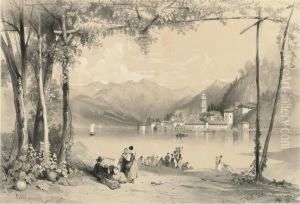Philip Johann Tabert Von Strahlenberg Paintings
Philip Johann Tabert von Strahlenberg, originally Phillip Johan Tabbert, was not primarily known as an artist but rather as a Swedish officer and geographer. Born on April 22, 1676, in Stralsund, which at that time was part of Swedish Pomerania (now Germany), he had a military career before becoming a noted figure in geography and ethnography.
Strahlenberg's life took a dramatic turn when he was captured by Russian forces during the Great Northern War at the Battle of Poltava in 1709. He spent the next 12 years in Siberia as a prisoner of war. It was during this time that he developed his interest in geography, studying the region's diverse geography, languages, and cultures. He is best known for his work in proposing a new boundary between Europe and Asia, which ran along the Ural Mountains, the Ural River, the Caspian Sea, the Caucasus Mountains, and the Black Sea, a delineation that is still largely in use today.
After his release in the 1720s, Strahlenberg returned to Sweden and published his influential book, 'Das Nord- und Ostliche Theil von Europa und Asia' (The Northern and Eastern Part of Europe and Asia) in 1730, which included his observations and a map featuring the Europe-Asia boundary he had proposed.
Strahlenberg is also remembered for his studies in linguistics; he was one of the first scholars to categorize the languages of the Ural-Altaic language family, which includes Finnish, Hungarian, Turkish, Mongolian, and others. His work influenced subsequent generations of linguists and ethnographers.
He died on September 7, 1747, in Stockholm, Sweden. Though he is not remembered primarily as an artist, his cartographic and scholarly work has left a lasting impact on the fields of geography and ethnography, bridging the gap between science and art through his detailed maps and observations of the vast and diverse territories of Russia and Siberia.
